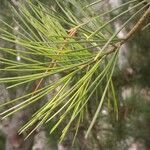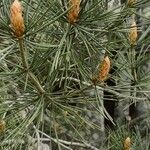Trees to 30 m tall; trunk monopodial or forked near base, to 3 m d.b.h.; bark irregularly flaking, inner bark pale, exfoliating in irregular, thin, scaly patches; crown broadly pyramidal or umbrellalike; 1st-year branchlets gray-green, glabrous; winter buds red-brown, ovoid, not resinous. Needles 3 per bundle, triangular-flabellate in cross section, 5-10 cm × 0.5-2 mm, stiff, vascular bundle 1, resin canals 6 or 7, marginal, rarely 1 or 2 median, base with sheath shed. Seed cones solitary, shortly pedunculate or subsessile, usually pale green, yellowish brown at maturity, ovoid or conical-ovoid, 5-7 × 4-6 cm. Seed scales broadly oblong-cuneate, apex thickened; apophyses subrhombic, obviously transversely ridged; umbo dorsal, triangular, protruding, usually terminating in a recurved spine. Seeds gray-brown, subobovoid, ca. 10 × 5-6 mm; wing loosely attached, ca. 5 mm. Pollination Apr-May, seed maturity Oct-Nov of 2nd year.
More
A tree. It grows to 30 m tall. The trunk is usually single but it can be forked near the base. The trunk is 3 m across. The bark flakes off irregularly. The bark can flake off in thin scaly patches. The crown can be like a pyramid or like an umbrella. The first year branches are grey-green. There are 3 needles in a bundle. They are triangle shaped in cross section. They are 5-10 cm long by 0.5-2 mm wide. They are stiff. The seed cones occur singly. They have short stalks. They are usually pale green or yellowish brown at maturity. The are oval and 5-7 cm long by 4-6 cm wide. The seeds are grey-brown and 10 mm long by 5-mm wide. The wing is loosely attached.
Scattered in mixed mountain forestss, often on limestone rocks and on south-facing slopes, also common on acid soils in the northern part of its range; at elevations from 500 -2,150 metres. Mud and sandstone shales, 1,000-1,250 metres.
More
It is a temperate plant. It grows in China in the mountains between 500-1800 m altitude. It suits hardiness zones 5-9. Arboretum Tasmania. Sydney Botanical gardens.
Can be grown by cuttings or seedlings. Seeds needs soaking.






